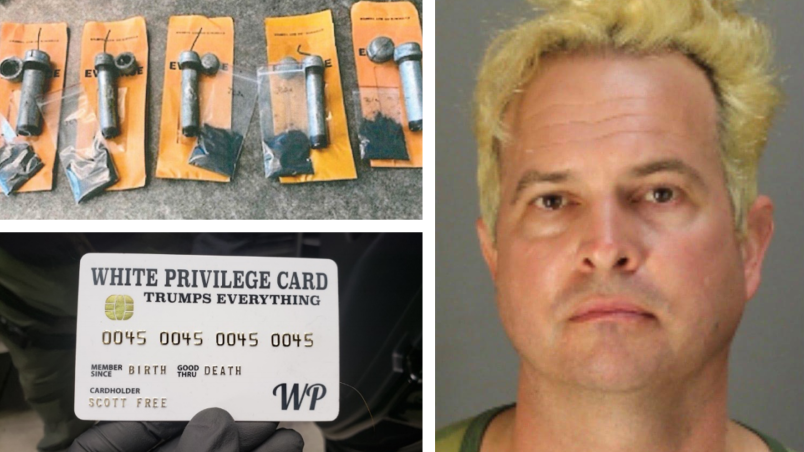Two California men have been indicted by a federal grand jury for allegedly plotting to attack the Democratic Party headquarters in Sacramento, part of what prosecutors say was a plan to inspire a “movement” among “patriots” following the 2020 election.
The indictment comes six months after one of the men was arrested on weapons charges after law enforcement allegedly found several pipe bombs at his home and business.
Jarrod Copeland and Ian Benjamin Rogers were charged federally in an indictment unsealed Wednesday. Rogers has faced months of state and federal court dates for the weapons charges, including unregistered possession of an explosive device, and has not yet entered a plea to the latest charges. Copeland pleaded not guilty Thursday.
“Prompted by the outcome of the 2020 Presidential election, on November 25, 2020, Rogers and Copeland began to plan an attack against a target or targets they associated with Democrats,” the federal indictment against the men read.
“By November 29, 2020, they had identified the John L. Burton Democratic Headquarters in Sacramento, California, as their first target, and made plans to attack it using incendiary devices. Rogers and Copeland believed that the attacks would start what they called a ‘movement.’ They discussed the attack in detail and on numerous occasions.”
In a detention memo for Copeland filed by prosecutors Thursday — Rogers remains in state custody facing several separate firearms charges — prosecutors quoted extensively from the pair’s alleged communications beginning last November, including their chatter about potentially using pipe bombs and attacking the governor’s mansion. Then, they allegedly changed their focus to the state party building.
“150 rounds shot into the building will destroy it,” Rogers allegedly told Copeland on Nov. 27, after linking to a map of the building.
“Yeah true,” Copeland allegedly responded.
“And a couple pipe bombs,” Rogers said.
“That pipe bomb that shit,” Copeland said.
The men also discussed how their actions would have political ramifications, prosecutors said.
“2 men can change the world if we want to,” Rogers allegedly wrote to Copeland, also on Nov. 27.
“We don’t need to win over 50,000 people we need 500 pissed off patriots that want America back,” Copeland responded.
The next day, they allegedly spoke further about the attack, including the idea of using “17 gallons of gas” to light the building on fire, in Rogers’ alleged words.
The pair discussed their plan for weeks, according to prosecutors’ memo, ultimately pegging it to the transition of power in Washington.
On Jan. 11, Rogers again allegedly mentioned the Sacramento office as a target — as well as the offices of Twitter and Facebook as secondary targets — saying he was “not going down without a fight.”
“I agree,” Copeland allegedly replied. “Plan attack.’
“Let’s see what happens after the 20th we go to war,” Rogers said, seemingly referring to the date of Joe Biden’s inauguration.
‘Delete All’
They didn’t have a chance: Officers raided Rogers’ home and business on Jan. 17, finding five fully assembled pipe bombs, dozens of firearms including three machine guns, and thousands of rounds of ammunition — and something claiming to be a “White Privilege Card.”
In addition to a conspiracy charge alleging the men plotted to destroy the Democratic Party building, Copeland faces another charge for what he did after Rogers’ arrest on weapons charges in January: After he learned of the arrest, Copeland allegedly contacted an anti-government militia group with which the pair had been in contact. (Prosecutors separately noted that Copeland was a member of an anti-government militia group affiliated with the so-called “3%er” movement.)
“Delete all,” the militia leader allegedly responded. “Jarrod, this sucks but we will get through it.”
Copeland allegedly agreed — leading to a charge for destruction of records in official proceedings — though his communications with Rogers were still present on Rogers’ phone, according to the indictment.
Rogers faces several new weapons charges as well, including for his alleged possession of a belt-fed machine gun and two AKM-style rifles. The prosecutors’ detention memo noted that authorities also found guns from Copeland’s home in January — as well as “at least two different kinds of anabolic steroids.”
Rogers hasn’t entered a plea in the federal case, and the attorneys representing him in that venue declined TPM’s request for comment.
Jess Raphael, who’s representing Rogers in the state case, told TPM that his client had engaged in “drunken bluster.”
“It’s clear that these were two ideologues who were caught up in the passion and drama of last January, and engaged in drunken bluster and rhetoric with no actual intent to act,” Raphael said.
“There is no evidence whatsoever that any preparatory actions were taken,” the attorney continued. “It was all intoxicated speech. Mr. Rogers has been collecting firearms for many years. They were not accumulated to promote any perceived plot. The pipe bombs were made long before the election strife with rudimentary materials like ammunition reload powder that Mr Rogers had on hand, with the intent to set them off on camping trips, blowing up tree stumps and the like. All were kept in a thick gun safe in his shop that kept them secure from accident.”
On Thursday prosecutors argued that Copeland should remain in government custody, as well.
“Both he and Rogers were animated by the kind [sic] anger that will not be abated or deterred by a court order,” prosecutors wrote. “And all of the political and social conditions that motivated them to plan what they themselves described as a terrorist attack remain. The only way to protect the public is to ensure that Copeland remains in custody.”



